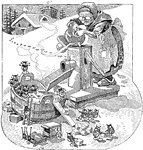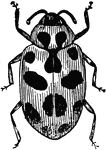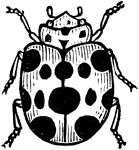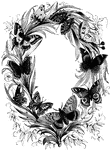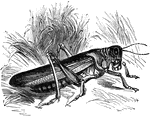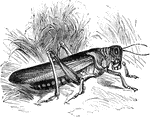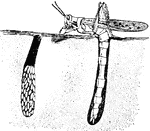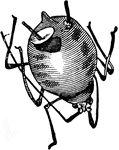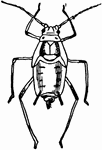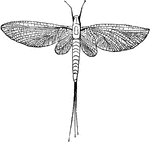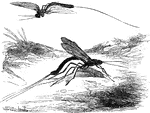
Ichneumon
"The ichineumons, with long ovipositors, as the European species, Ichneumon manifestator, seek…

Ichneumon Fly
The Ichneumonoidea are insects classified in the hymenopteran suborder Apocrita. The super family is…

Ichneumon Fly
Ichneumon flies are solitary insects, and most are parasitoids—the larvae feeding on or in another…

Ichneumon Fly
Ichneumon flies are solitary insects, and most are parasitoids—the larvae feeding on or in another…

Ichneumon Fly
"Gonatopus contortulus. A genus of ichneumon-flies of the family Proctotrupidae and subfamily Dryininae,…
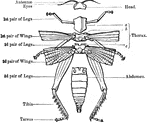
External Anatomy of an Insect Skeleton
"Anatomy of the external skeleton of an insect" — Goodrich, 1859

Digestive Apparatus of an Insect
"a, head, antennae, &c; b, pharynx; c, crop; d, gizzard; e, chyle-forming stomach; f, biliary vessels;…

Diagram of the External Structure of an Insect
A diagram of the external structure of an insect. Labels: 1, The head carrying the eyes and the antennae.…

Lackey Moth
Bombyx Neustria, or the lackey moth, lay their eggs on the twigs of various trees. When the larvae emerge…
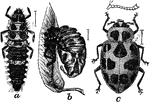
Spotted Ladybird
Also known as megilla maculata. A-Larva; B-Empty skin; C-Beetle with enlarged antenna above.

Larva
The larva of a weevil. A larva is a juvenile form of animal with indirect development, undergoing metamorphosis.
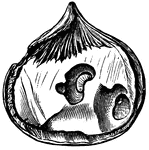
Larva in Chestnut
The larva of a weevil in a chestnut. A larva is a juvenile form of animal with indirect development,…
Eight-Spotted Forester Larva
The larva Eight-Spotted Forester (Alypia octomaculata), a caterpillar belonging to the Noctuidae family…
Mealworm Larva
Mealworms are the larva form of the mealworm beetle, Tenebrio molitor, a species of darkling beetle.…

Leaf Insect
The leaf insect or walking leaf is an insect that has the appearance of a leaf from the family Phylliidae.
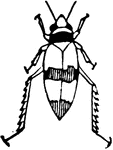
Threebanded Grape Leafhopper Imago
The imago stage of the Threebanded Grape Leafhopper (Erythroneura tricincta) is an insect in the Cicadellidae…

Threebanded Grape Leafhopper Imago
The imago stage of the Threebanded Grape Leafhopper (Erythroneura tricincta) is an insect in the Cicadellidae…

Threebanded Grape Leafhopper Pupa
The pupa of the Threebanded Grape Leafhopper (Erythroneura tricincta) is an insect in the Cicadellidae…
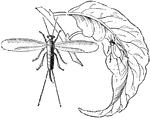
Lecanium Persicae
Pictured is a leaf with a male on it, slightly enlarge (a) and a male flying, much enlarged (b). Lecanium…
Larva of a Leopard Moth
Larva are unlike the mature insect. Larva of the moth or butterfly resemble worms. It may have a distinct…
Eggs, Larvae, and Perfect Insect of the Lily Beetle
The larvae of the lily beetle live on lilies, devouring their leaves. The antennae are on the front…

Locust
"The locusts come down in swarms of millions from the warm lands of southern Brazil. There are so many…

Seventeen Year Locust
The Seventeen Year Locust (Cicada septendecim) spends seventeen years underground feeding on the roots…
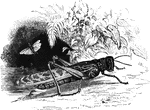
Locusta Cristata
"The migratory locust measures about two and a half inches in length, and some other exotic species…

Locusts
"Locusts, which, from their often collecting in vast swarms, and moving onward with a steady and irresistable…

Magnified Louse
"A genus of insects, the type of a very numerous family, which forms the order Parasita or Auoplura.…
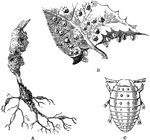
Grape or Vine Louse
The grape or vine louse belongs to the Aphides, or Green Flies. The insect lives on the European vine.…

Hop Louse
"Hop louse which lives on the plum tree in the late fall, winter, and early spring until the hop vines…

Larvae and Web of Lyda Pyri
Lyda is a genus of sawflies. Lyda pyri injure plums and other stone fruit trees. The habits of the larvae…

Maize Kernels Destroyed by Maggots
Illustration of two small corn (maize) kernels being eaten by maggots. One maggot is still inside one…

Praying Mantis
"The Mantis is one of the most voracious of its class, and only assumes this solemn and devout appearance…

Praying Mantis
"Probably no other insect has been the subject of so many and widespread legends and superstitions as…

Mayfly
"Young may-fly or ephemerid. Showing tracheal gills, and wings appearing in front of them." -Thomson,…

Mealworm
"Tenebrio Molitor. Commonly known as the mealworm or the mealworm beetle. Common in Europe and in this…

Mealworm Beetle
The flour or mealworm beetle (Tenebrio molitor) is an insect in the Tenebrionidae family darkling beetles.
Millipede
Millipedes are usually cylindrical. The origins of the legs are usually brought very close to the middle…
Mole Cricket
The mole cricket has a smoky brown color above and a yellowish red below. The cricket has a velvety…





